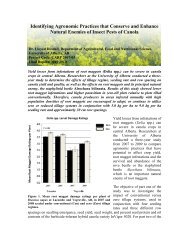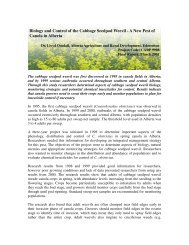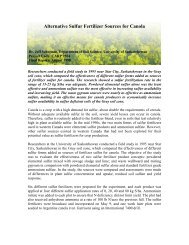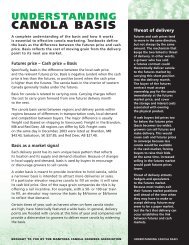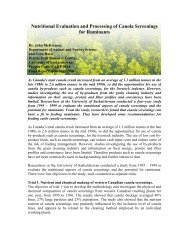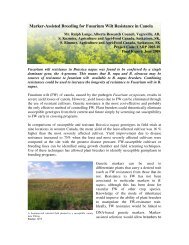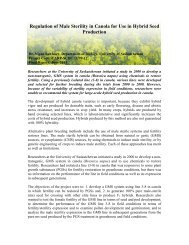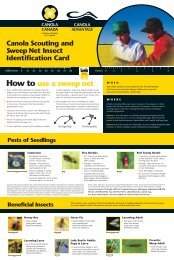Canola Digest, January 2013 - SaskCanola
Canola Digest, January 2013 - SaskCanola
Canola Digest, January 2013 - SaskCanola
You also want an ePaper? Increase the reach of your titles
YUMPU automatically turns print PDFs into web optimized ePapers that Google loves.
DIAGNOSTIC DILEMMAS<br />
continued from page 25<br />
26<br />
2. YELLOWS, NOT GOODBYES<br />
Problem: Aster yellows is not an issue<br />
most years, but 2012 was a bad year,<br />
with 10 percent of plants in the disease<br />
survey showing visual damage and<br />
25 percent testing positive in DNA tests.<br />
Agriculture and Agri-Food Canada<br />
(AAFC) biologist Chrystel Olivier gives<br />
these reasons:<br />
• Milder winters allowed local leafhopper<br />
populations to survive and<br />
build up, and allowed more infected<br />
plants to overwinter. Leafhoppers<br />
carry aster yellows phytoplasma and<br />
their feeding transfers it to plants.<br />
• Drought and a mild winter in the<br />
U.S. may have increased the<br />
abundance of the leafhopper and<br />
their level of infection.<br />
• South winds arrived in the Prairies<br />
earlier in 2012, bringing leafhoppers<br />
with them.<br />
Hormone imbalance from extreme<br />
heat may have made some aster<br />
yellows symptoms worse or different<br />
than what we’ve been used to in canola.<br />
CanoLab <strong>2013</strong> will look at some of<br />
these relationships, by putting canola<br />
plants under various levels of temperature<br />
stress and then infecting some<br />
with aster yellows and leaving some<br />
uninfected to see how symptoms differ.<br />
“CanoLab is not research based, but<br />
we’re doing these tests to start people<br />
thinking how cumulative stresses<br />
interact,” says Dan Orchard, CCC<br />
agronomy specialist. (For more on<br />
CanoLab <strong>2013</strong> and aster yellows, do a<br />
search at www.canolawatch.org)<br />
Action for <strong>2013</strong>: Control weeds.<br />
Leafhoppers feed on many crops, and<br />
canola is not their first choice. A weedy<br />
canola field gives leafhoppers food<br />
choice and may make canola crops more<br />
attractive to them. Perennial weeds<br />
can also provide an overwintering host<br />
for the phytoplasma. “Perennial weeds<br />
and plants are potentially a strong<br />
disease reservoir for phytoplasma and<br />
the likelihood of aster yellows being<br />
transmitted from the reservoir to the<br />
crop is high,” says Olivier.<br />
Spraying leafhoppers may help reduce<br />
infection rates in canola, but developing<br />
an economic threshold is difficult<br />
because leafhoppers are not damaging<br />
the canola directly. A reliable prediction<br />
of economic benefit requires knowledge<br />
of the amount of phytoplasma transmission<br />
taking place from the insects<br />
to the crop, and of the amount of disease<br />
development likely to occur based on<br />
crop stage and environment.<br />
A weedy canola field gives<br />
leafhoppers food choice and<br />
may make canola crops more<br />
attractive to them.<br />
“We don’t really want to recommend<br />
growers spray for leafhoppers because<br />
we don’t know what’s economic, but<br />
it would be helpful to have an early<br />
warning system to identify arrival of<br />
the leafhoppers and what percentage<br />
is carrying the phytoplasma,” says<br />
Orchard. “We may find that if<br />
leafhoppers numbers are concentrated<br />
in ditches or tree lines near canola crops,<br />
then maybe a localized spray before<br />
the crop even emerges can be effective.<br />
But again, we don’t really know.”<br />
3 BUDGET FOR ROT PATROL<br />
Problem: Central and northwestern<br />
Saskatchewan and eastern Alberta had<br />
a lot of rain through the critical period<br />
for sclerotinia stem rot. Disease levels<br />
were high, and many unsprayed fields<br />
were hit hard.<br />
“Geography is not immunity,” says<br />
Clint Jurke, CCC agronomy specialist.<br />
“Sclerotinia spores are in all canola<br />
growing regions of the Prairies, and<br />
if conditions are moist before, during<br />
and after flowering, you can expect<br />
costly infection.”<br />
Action for <strong>2013</strong>: Put fungicide in your<br />
canola budget. You may not need to<br />
spray if conditions are clearly not<br />
conducive to sclerotinia – dry with low<br />
yield potential – but with a budget in<br />
place, you can act in a timely manner<br />
to get the best return on that fungicide<br />
investment.<br />
Seeding rate can influence sclerotinia<br />
stem rot severity. Crops with a higher<br />
plant density usually have more even<br />
maturity and a shorter flowering period,<br />
making it easier to choose the correct<br />
spray timing for sclerotinia. Uneven<br />
crops and crops with low plant counts<br />
may be good candidates for a split spray,<br />
two applications.<br />
“Sclerotinia spores are in all<br />
canola growing regions of<br />
the Prairies, and if conditions<br />
are moist before, during and<br />
after flowering, you can expect<br />
costly infection.”<br />
– Clint Jurke<br />
This pod is from a plant that tested positive<br />
for aster yellows. Seeds are clearly affected but the pod<br />
did not have the bladder shape typical of aster yellows.<br />
4. WE HAVE SEEN THE WIND<br />
Problem: <strong>Canola</strong> crops leave an average<br />
of two to three bushels per acre of seed<br />
in the field, but heavy winds that made<br />
a mess of mature canola fields in 2012<br />
increased these losses significantly.



